Mental State Examination Assignment
VerifiedAdded on 2021/01/08
|8
|2340
|168
AI Summary
Contribute Materials
Your contribution can guide someone’s learning journey. Share your
documents today.
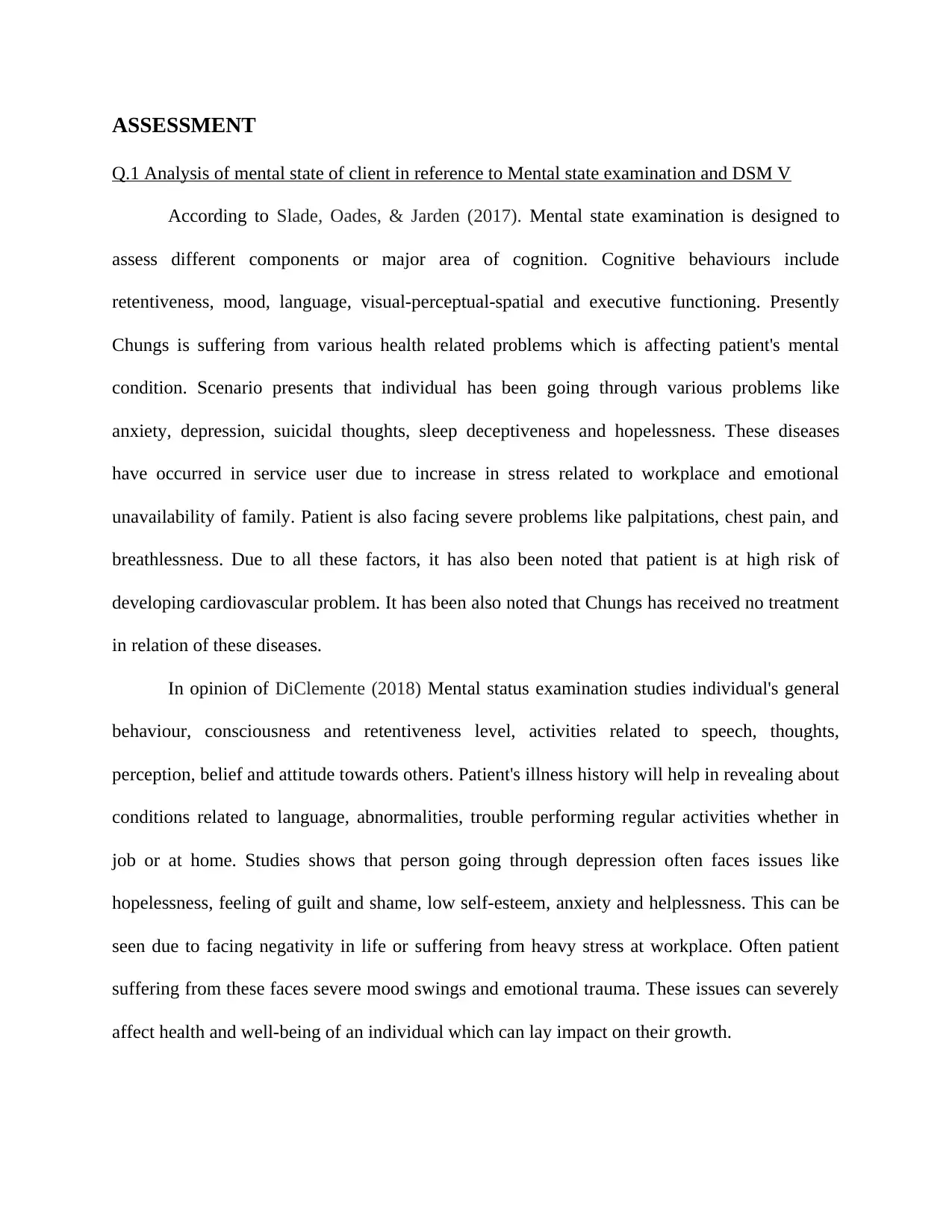
ASSESSMENT
Q.1 Analysis of mental state of client in reference to Mental state examination and DSM V
According to Slade, Oades, & Jarden (2017). Mental state examination is designed to
assess different components or major area of cognition. Cognitive behaviours include
retentiveness, mood, language, visual-perceptual-spatial and executive functioning. Presently
Chungs is suffering from various health related problems which is affecting patient's mental
condition. Scenario presents that individual has been going through various problems like
anxiety, depression, suicidal thoughts, sleep deceptiveness and hopelessness. These diseases
have occurred in service user due to increase in stress related to workplace and emotional
unavailability of family. Patient is also facing severe problems like palpitations, chest pain, and
breathlessness. Due to all these factors, it has also been noted that patient is at high risk of
developing cardiovascular problem. It has been also noted that Chungs has received no treatment
in relation of these diseases.
In opinion of DiClemente (2018) Mental status examination studies individual's general
behaviour, consciousness and retentiveness level, activities related to speech, thoughts,
perception, belief and attitude towards others. Patient's illness history will help in revealing about
conditions related to language, abnormalities, trouble performing regular activities whether in
job or at home. Studies shows that person going through depression often faces issues like
hopelessness, feeling of guilt and shame, low self-esteem, anxiety and helplessness. This can be
seen due to facing negativity in life or suffering from heavy stress at workplace. Often patient
suffering from these faces severe mood swings and emotional trauma. These issues can severely
affect health and well-being of an individual which can lay impact on their growth.
Q.1 Analysis of mental state of client in reference to Mental state examination and DSM V
According to Slade, Oades, & Jarden (2017). Mental state examination is designed to
assess different components or major area of cognition. Cognitive behaviours include
retentiveness, mood, language, visual-perceptual-spatial and executive functioning. Presently
Chungs is suffering from various health related problems which is affecting patient's mental
condition. Scenario presents that individual has been going through various problems like
anxiety, depression, suicidal thoughts, sleep deceptiveness and hopelessness. These diseases
have occurred in service user due to increase in stress related to workplace and emotional
unavailability of family. Patient is also facing severe problems like palpitations, chest pain, and
breathlessness. Due to all these factors, it has also been noted that patient is at high risk of
developing cardiovascular problem. It has been also noted that Chungs has received no treatment
in relation of these diseases.
In opinion of DiClemente (2018) Mental status examination studies individual's general
behaviour, consciousness and retentiveness level, activities related to speech, thoughts,
perception, belief and attitude towards others. Patient's illness history will help in revealing about
conditions related to language, abnormalities, trouble performing regular activities whether in
job or at home. Studies shows that person going through depression often faces issues like
hopelessness, feeling of guilt and shame, low self-esteem, anxiety and helplessness. This can be
seen due to facing negativity in life or suffering from heavy stress at workplace. Often patient
suffering from these faces severe mood swings and emotional trauma. These issues can severely
affect health and well-being of an individual which can lay impact on their growth.
Secure Best Marks with AI Grader
Need help grading? Try our AI Grader for instant feedback on your assignments.
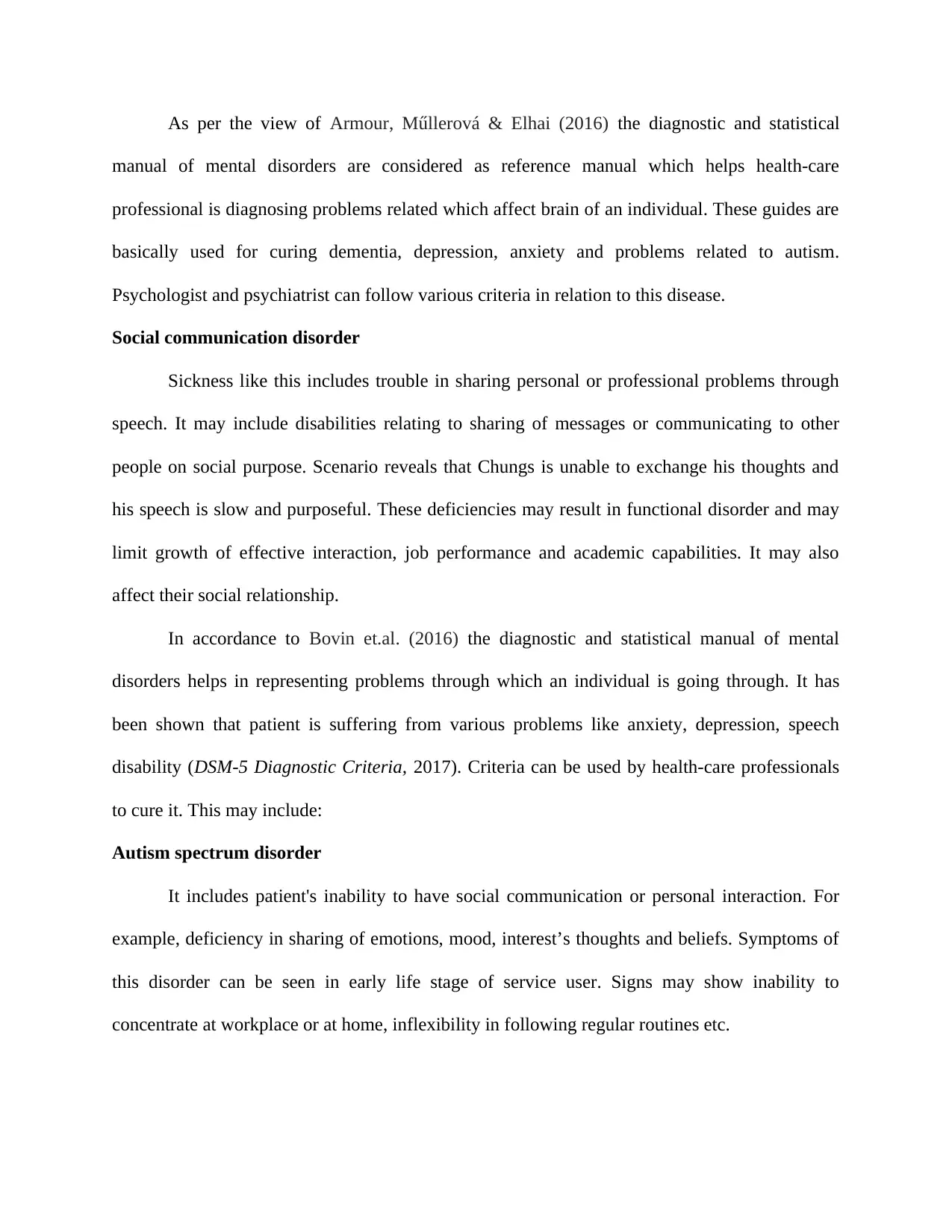
As per the view of Armour, Műllerová & Elhai (2016) the diagnostic and statistical
manual of mental disorders are considered as reference manual which helps health-care
professional is diagnosing problems related which affect brain of an individual. These guides are
basically used for curing dementia, depression, anxiety and problems related to autism.
Psychologist and psychiatrist can follow various criteria in relation to this disease.
Social communication disorder
Sickness like this includes trouble in sharing personal or professional problems through
speech. It may include disabilities relating to sharing of messages or communicating to other
people on social purpose. Scenario reveals that Chungs is unable to exchange his thoughts and
his speech is slow and purposeful. These deficiencies may result in functional disorder and may
limit growth of effective interaction, job performance and academic capabilities. It may also
affect their social relationship.
In accordance to Bovin et.al. (2016) the diagnostic and statistical manual of mental
disorders helps in representing problems through which an individual is going through. It has
been shown that patient is suffering from various problems like anxiety, depression, speech
disability (DSM-5 Diagnostic Criteria, 2017). Criteria can be used by health-care professionals
to cure it. This may include:
Autism spectrum disorder
It includes patient's inability to have social communication or personal interaction. For
example, deficiency in sharing of emotions, mood, interest’s thoughts and beliefs. Symptoms of
this disorder can be seen in early life stage of service user. Signs may show inability to
concentrate at workplace or at home, inflexibility in following regular routines etc.
manual of mental disorders are considered as reference manual which helps health-care
professional is diagnosing problems related which affect brain of an individual. These guides are
basically used for curing dementia, depression, anxiety and problems related to autism.
Psychologist and psychiatrist can follow various criteria in relation to this disease.
Social communication disorder
Sickness like this includes trouble in sharing personal or professional problems through
speech. It may include disabilities relating to sharing of messages or communicating to other
people on social purpose. Scenario reveals that Chungs is unable to exchange his thoughts and
his speech is slow and purposeful. These deficiencies may result in functional disorder and may
limit growth of effective interaction, job performance and academic capabilities. It may also
affect their social relationship.
In accordance to Bovin et.al. (2016) the diagnostic and statistical manual of mental
disorders helps in representing problems through which an individual is going through. It has
been shown that patient is suffering from various problems like anxiety, depression, speech
disability (DSM-5 Diagnostic Criteria, 2017). Criteria can be used by health-care professionals
to cure it. This may include:
Autism spectrum disorder
It includes patient's inability to have social communication or personal interaction. For
example, deficiency in sharing of emotions, mood, interest’s thoughts and beliefs. Symptoms of
this disorder can be seen in early life stage of service user. Signs may show inability to
concentrate at workplace or at home, inflexibility in following regular routines etc.
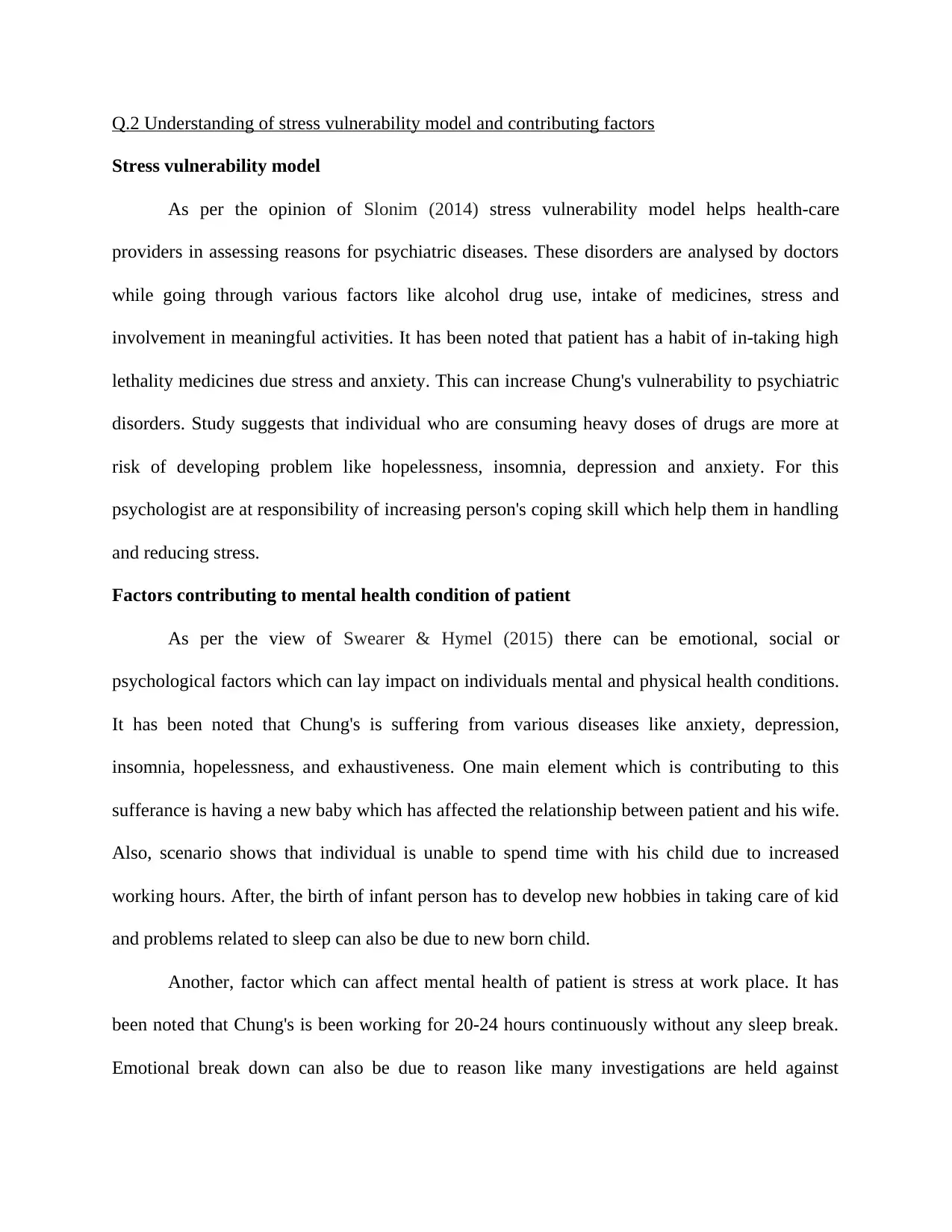
Q.2 Understanding of stress vulnerability model and contributing factors
Stress vulnerability model
As per the opinion of Slonim (2014) stress vulnerability model helps health-care
providers in assessing reasons for psychiatric diseases. These disorders are analysed by doctors
while going through various factors like alcohol drug use, intake of medicines, stress and
involvement in meaningful activities. It has been noted that patient has a habit of in-taking high
lethality medicines due stress and anxiety. This can increase Chung's vulnerability to psychiatric
disorders. Study suggests that individual who are consuming heavy doses of drugs are more at
risk of developing problem like hopelessness, insomnia, depression and anxiety. For this
psychologist are at responsibility of increasing person's coping skill which help them in handling
and reducing stress.
Factors contributing to mental health condition of patient
As per the view of Swearer & Hymel (2015) there can be emotional, social or
psychological factors which can lay impact on individuals mental and physical health conditions.
It has been noted that Chung's is suffering from various diseases like anxiety, depression,
insomnia, hopelessness, and exhaustiveness. One main element which is contributing to this
sufferance is having a new baby which has affected the relationship between patient and his wife.
Also, scenario shows that individual is unable to spend time with his child due to increased
working hours. After, the birth of infant person has to develop new hobbies in taking care of kid
and problems related to sleep can also be due to new born child.
Another, factor which can affect mental health of patient is stress at work place. It has
been noted that Chung's is been working for 20-24 hours continuously without any sleep break.
Emotional break down can also be due to reason like many investigations are held against
Stress vulnerability model
As per the opinion of Slonim (2014) stress vulnerability model helps health-care
providers in assessing reasons for psychiatric diseases. These disorders are analysed by doctors
while going through various factors like alcohol drug use, intake of medicines, stress and
involvement in meaningful activities. It has been noted that patient has a habit of in-taking high
lethality medicines due stress and anxiety. This can increase Chung's vulnerability to psychiatric
disorders. Study suggests that individual who are consuming heavy doses of drugs are more at
risk of developing problem like hopelessness, insomnia, depression and anxiety. For this
psychologist are at responsibility of increasing person's coping skill which help them in handling
and reducing stress.
Factors contributing to mental health condition of patient
As per the view of Swearer & Hymel (2015) there can be emotional, social or
psychological factors which can lay impact on individuals mental and physical health conditions.
It has been noted that Chung's is suffering from various diseases like anxiety, depression,
insomnia, hopelessness, and exhaustiveness. One main element which is contributing to this
sufferance is having a new baby which has affected the relationship between patient and his wife.
Also, scenario shows that individual is unable to spend time with his child due to increased
working hours. After, the birth of infant person has to develop new hobbies in taking care of kid
and problems related to sleep can also be due to new born child.
Another, factor which can affect mental health of patient is stress at work place. It has
been noted that Chung's is been working for 20-24 hours continuously without any sleep break.
Emotional break down can also be due to reason like many investigations are held against
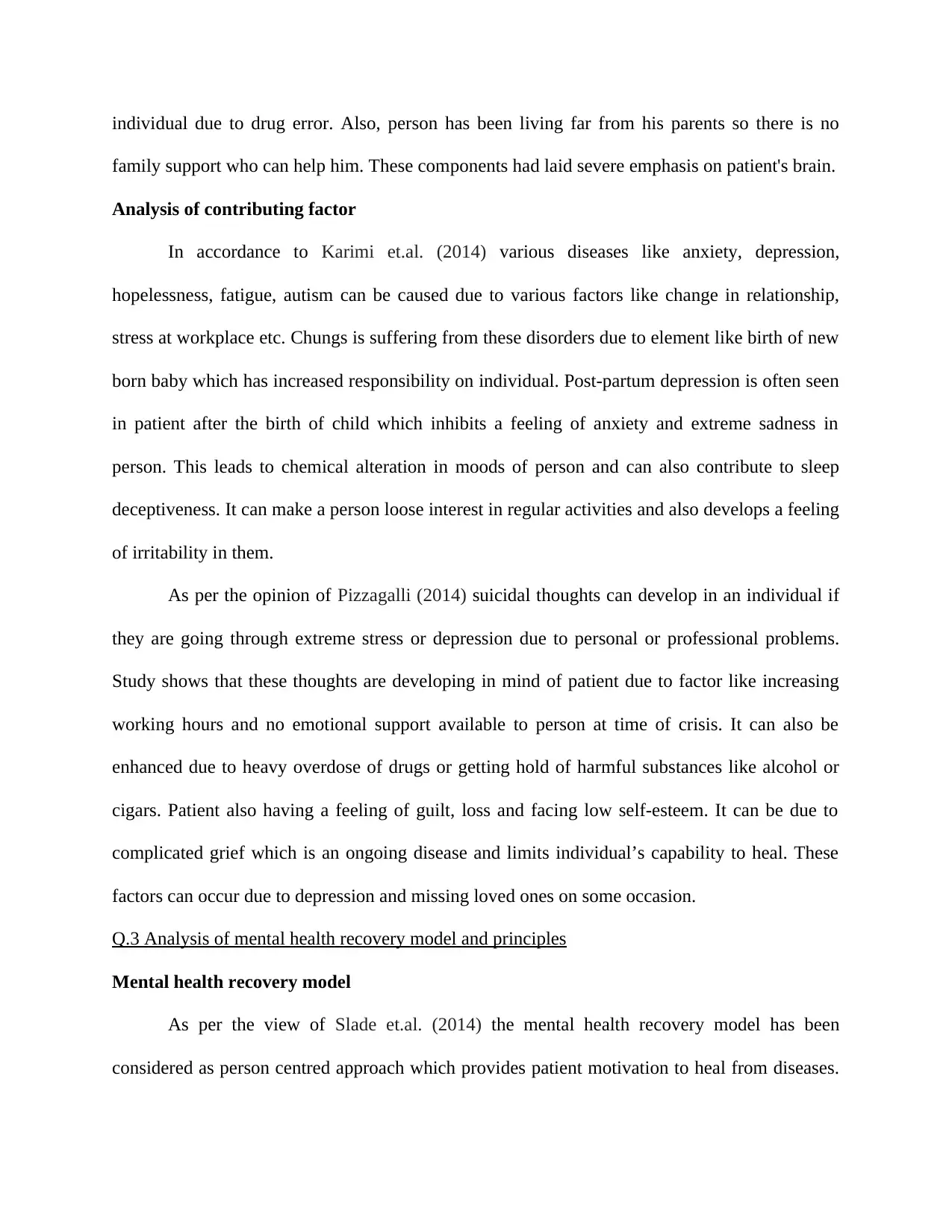
individual due to drug error. Also, person has been living far from his parents so there is no
family support who can help him. These components had laid severe emphasis on patient's brain.
Analysis of contributing factor
In accordance to Karimi et.al. (2014) various diseases like anxiety, depression,
hopelessness, fatigue, autism can be caused due to various factors like change in relationship,
stress at workplace etc. Chungs is suffering from these disorders due to element like birth of new
born baby which has increased responsibility on individual. Post-partum depression is often seen
in patient after the birth of child which inhibits a feeling of anxiety and extreme sadness in
person. This leads to chemical alteration in moods of person and can also contribute to sleep
deceptiveness. It can make a person loose interest in regular activities and also develops a feeling
of irritability in them.
As per the opinion of Pizzagalli (2014) suicidal thoughts can develop in an individual if
they are going through extreme stress or depression due to personal or professional problems.
Study shows that these thoughts are developing in mind of patient due to factor like increasing
working hours and no emotional support available to person at time of crisis. It can also be
enhanced due to heavy overdose of drugs or getting hold of harmful substances like alcohol or
cigars. Patient also having a feeling of guilt, loss and facing low self-esteem. It can be due to
complicated grief which is an ongoing disease and limits individual’s capability to heal. These
factors can occur due to depression and missing loved ones on some occasion.
Q.3 Analysis of mental health recovery model and principles
Mental health recovery model
As per the view of Slade et.al. (2014) the mental health recovery model has been
considered as person centred approach which provides patient motivation to heal from diseases.
family support who can help him. These components had laid severe emphasis on patient's brain.
Analysis of contributing factor
In accordance to Karimi et.al. (2014) various diseases like anxiety, depression,
hopelessness, fatigue, autism can be caused due to various factors like change in relationship,
stress at workplace etc. Chungs is suffering from these disorders due to element like birth of new
born baby which has increased responsibility on individual. Post-partum depression is often seen
in patient after the birth of child which inhibits a feeling of anxiety and extreme sadness in
person. This leads to chemical alteration in moods of person and can also contribute to sleep
deceptiveness. It can make a person loose interest in regular activities and also develops a feeling
of irritability in them.
As per the opinion of Pizzagalli (2014) suicidal thoughts can develop in an individual if
they are going through extreme stress or depression due to personal or professional problems.
Study shows that these thoughts are developing in mind of patient due to factor like increasing
working hours and no emotional support available to person at time of crisis. It can also be
enhanced due to heavy overdose of drugs or getting hold of harmful substances like alcohol or
cigars. Patient also having a feeling of guilt, loss and facing low self-esteem. It can be due to
complicated grief which is an ongoing disease and limits individual’s capability to heal. These
factors can occur due to depression and missing loved ones on some occasion.
Q.3 Analysis of mental health recovery model and principles
Mental health recovery model
As per the view of Slade et.al. (2014) the mental health recovery model has been
considered as person centred approach which provides patient motivation to heal from diseases.
Secure Best Marks with AI Grader
Need help grading? Try our AI Grader for instant feedback on your assignments.
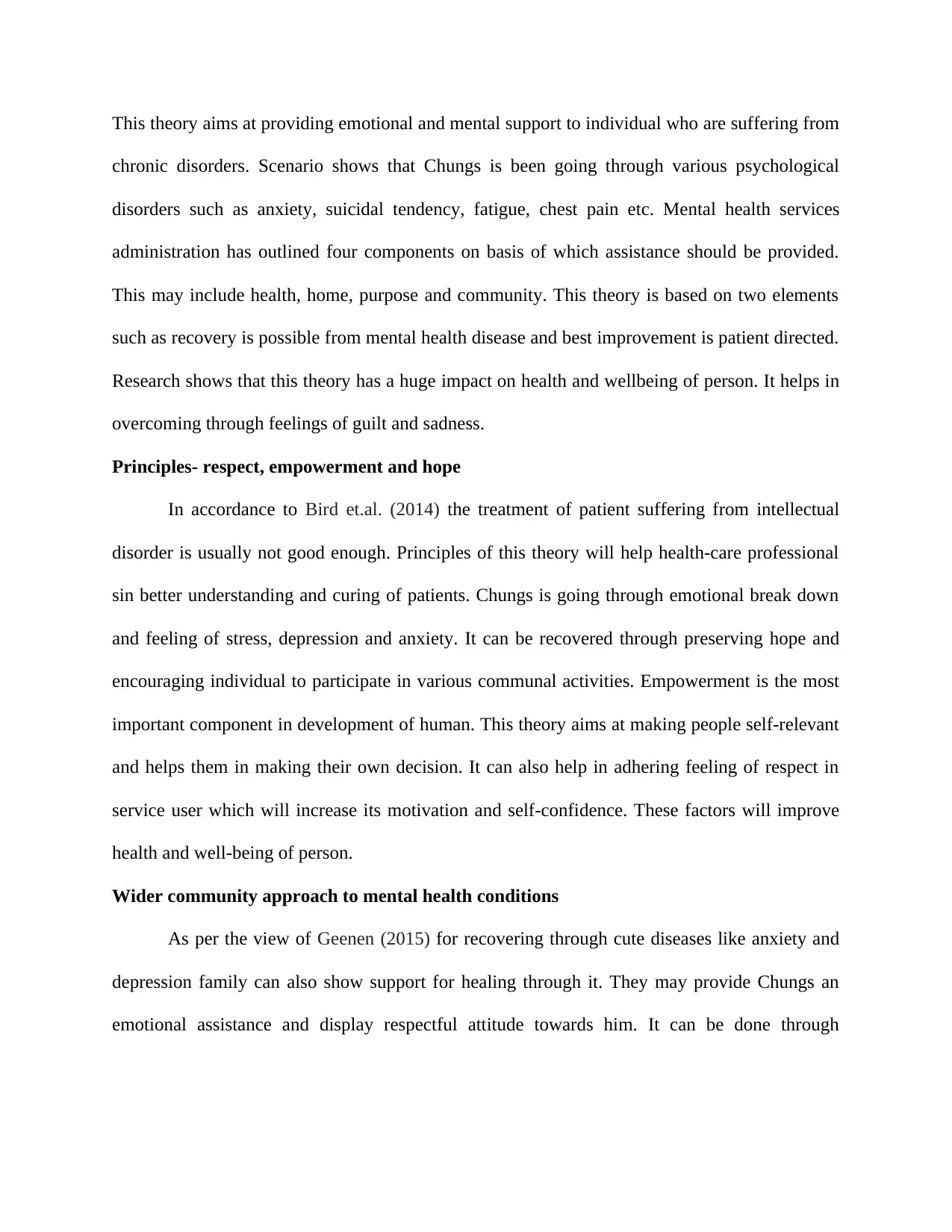
This theory aims at providing emotional and mental support to individual who are suffering from
chronic disorders. Scenario shows that Chungs is been going through various psychological
disorders such as anxiety, suicidal tendency, fatigue, chest pain etc. Mental health services
administration has outlined four components on basis of which assistance should be provided.
This may include health, home, purpose and community. This theory is based on two elements
such as recovery is possible from mental health disease and best improvement is patient directed.
Research shows that this theory has a huge impact on health and wellbeing of person. It helps in
overcoming through feelings of guilt and sadness.
Principles- respect, empowerment and hope
In accordance to Bird et.al. (2014) the treatment of patient suffering from intellectual
disorder is usually not good enough. Principles of this theory will help health-care professional
sin better understanding and curing of patients. Chungs is going through emotional break down
and feeling of stress, depression and anxiety. It can be recovered through preserving hope and
encouraging individual to participate in various communal activities. Empowerment is the most
important component in development of human. This theory aims at making people self-relevant
and helps them in making their own decision. It can also help in adhering feeling of respect in
service user which will increase its motivation and self-confidence. These factors will improve
health and well-being of person.
Wider community approach to mental health conditions
As per the view of Geenen (2015) for recovering through cute diseases like anxiety and
depression family can also show support for healing through it. They may provide Chungs an
emotional assistance and display respectful attitude towards him. It can be done through
chronic disorders. Scenario shows that Chungs is been going through various psychological
disorders such as anxiety, suicidal tendency, fatigue, chest pain etc. Mental health services
administration has outlined four components on basis of which assistance should be provided.
This may include health, home, purpose and community. This theory is based on two elements
such as recovery is possible from mental health disease and best improvement is patient directed.
Research shows that this theory has a huge impact on health and wellbeing of person. It helps in
overcoming through feelings of guilt and sadness.
Principles- respect, empowerment and hope
In accordance to Bird et.al. (2014) the treatment of patient suffering from intellectual
disorder is usually not good enough. Principles of this theory will help health-care professional
sin better understanding and curing of patients. Chungs is going through emotional break down
and feeling of stress, depression and anxiety. It can be recovered through preserving hope and
encouraging individual to participate in various communal activities. Empowerment is the most
important component in development of human. This theory aims at making people self-relevant
and helps them in making their own decision. It can also help in adhering feeling of respect in
service user which will increase its motivation and self-confidence. These factors will improve
health and well-being of person.
Wider community approach to mental health conditions
As per the view of Geenen (2015) for recovering through cute diseases like anxiety and
depression family can also show support for healing through it. They may provide Chungs an
emotional assistance and display respectful attitude towards him. It can be done through
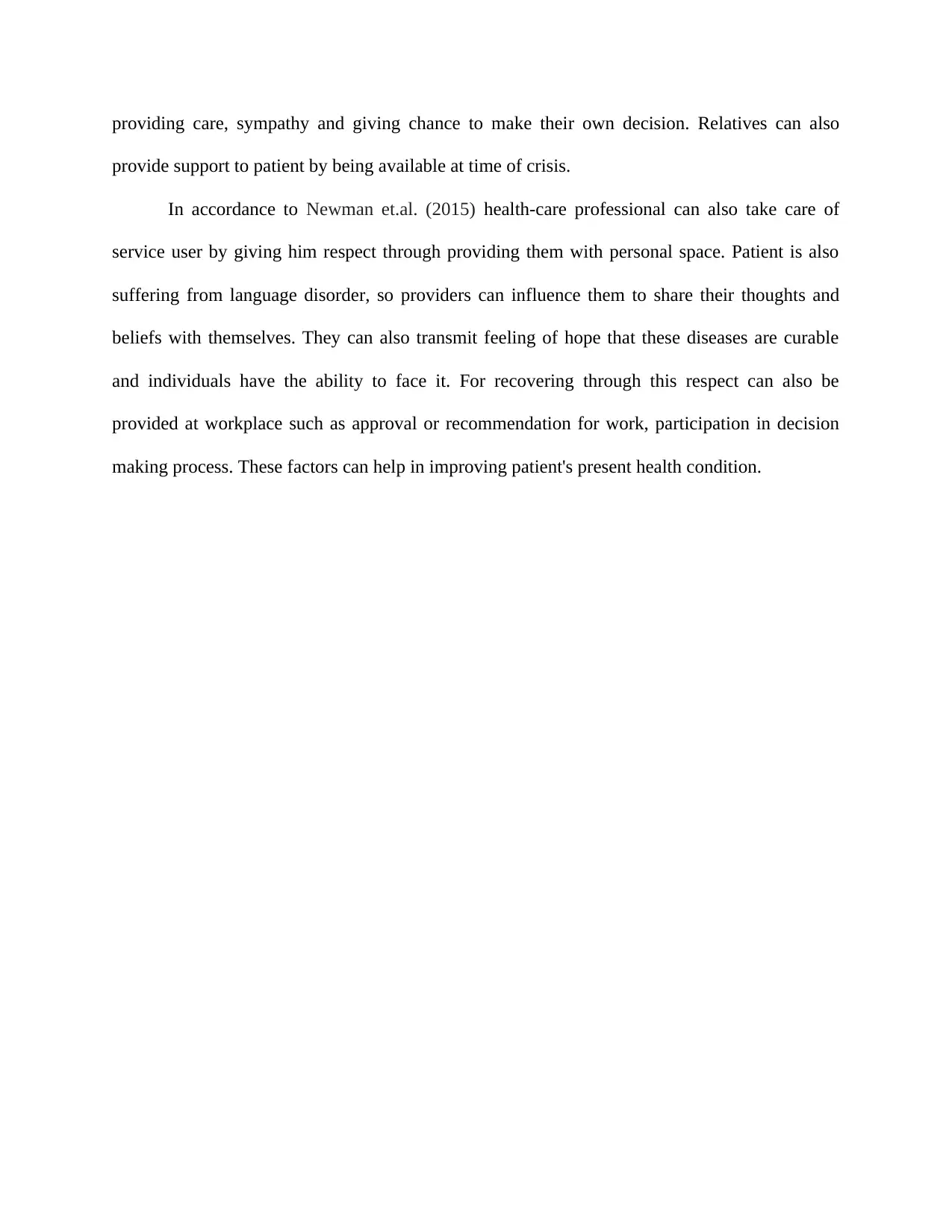
providing care, sympathy and giving chance to make their own decision. Relatives can also
provide support to patient by being available at time of crisis.
In accordance to Newman et.al. (2015) health-care professional can also take care of
service user by giving him respect through providing them with personal space. Patient is also
suffering from language disorder, so providers can influence them to share their thoughts and
beliefs with themselves. They can also transmit feeling of hope that these diseases are curable
and individuals have the ability to face it. For recovering through this respect can also be
provided at workplace such as approval or recommendation for work, participation in decision
making process. These factors can help in improving patient's present health condition.
provide support to patient by being available at time of crisis.
In accordance to Newman et.al. (2015) health-care professional can also take care of
service user by giving him respect through providing them with personal space. Patient is also
suffering from language disorder, so providers can influence them to share their thoughts and
beliefs with themselves. They can also transmit feeling of hope that these diseases are curable
and individuals have the ability to face it. For recovering through this respect can also be
provided at workplace such as approval or recommendation for work, participation in decision
making process. These factors can help in improving patient's present health condition.
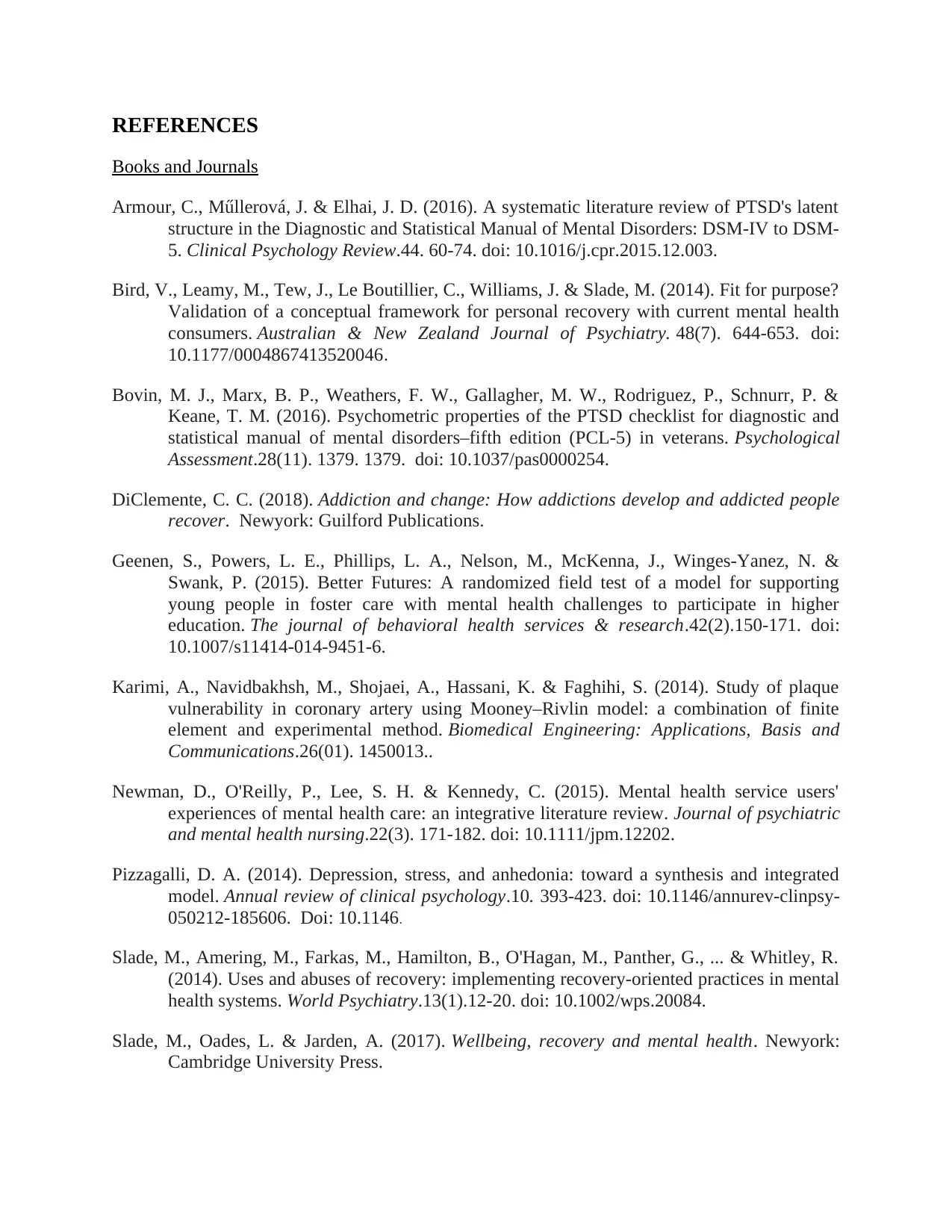
REFERENCES
Books and Journals
Armour, C., Műllerová, J. & Elhai, J. D. (2016). A systematic literature review of PTSD's latent
structure in the Diagnostic and Statistical Manual of Mental Disorders: DSM-IV to DSM-
5. Clinical Psychology Review.44. 60-74. doi: 10.1016/j.cpr.2015.12.003.
Bird, V., Leamy, M., Tew, J., Le Boutillier, C., Williams, J. & Slade, M. (2014). Fit for purpose?
Validation of a conceptual framework for personal recovery with current mental health
consumers. Australian & New Zealand Journal of Psychiatry. 48(7). 644-653. doi:
10.1177/0004867413520046.
Bovin, M. J., Marx, B. P., Weathers, F. W., Gallagher, M. W., Rodriguez, P., Schnurr, P. &
Keane, T. M. (2016). Psychometric properties of the PTSD checklist for diagnostic and
statistical manual of mental disorders–fifth edition (PCL-5) in veterans. Psychological
Assessment.28(11). 1379. 1379. doi: 10.1037/pas0000254.
DiClemente, C. C. (2018). Addiction and change: How addictions develop and addicted people
recover. Newyork: Guilford Publications.
Geenen, S., Powers, L. E., Phillips, L. A., Nelson, M., McKenna, J., Winges-Yanez, N. &
Swank, P. (2015). Better Futures: A randomized field test of a model for supporting
young people in foster care with mental health challenges to participate in higher
education. The journal of behavioral health services & research.42(2).150-171. doi:
10.1007/s11414-014-9451-6.
Karimi, A., Navidbakhsh, M., Shojaei, A., Hassani, K. & Faghihi, S. (2014). Study of plaque
vulnerability in coronary artery using Mooney–Rivlin model: a combination of finite
element and experimental method. Biomedical Engineering: Applications, Basis and
Communications.26(01). 1450013..
Newman, D., O'Reilly, P., Lee, S. H. & Kennedy, C. (2015). Mental health service users'
experiences of mental health care: an integrative literature review. Journal of psychiatric
and mental health nursing.22(3). 171-182. doi: 10.1111/jpm.12202.
Pizzagalli, D. A. (2014). Depression, stress, and anhedonia: toward a synthesis and integrated
model. Annual review of clinical psychology.10. 393-423. doi: 10.1146/annurev-clinpsy-
050212-185606. Doi: 10.1146.
Slade, M., Amering, M., Farkas, M., Hamilton, B., O'Hagan, M., Panther, G., ... & Whitley, R.
(2014). Uses and abuses of recovery: implementing recovery‐oriented practices in mental
health systems. World Psychiatry.13(1).12-20. doi: 10.1002/wps.20084.
Slade, M., Oades, L. & Jarden, A. (2017). Wellbeing, recovery and mental health. Newyork:
Cambridge University Press.
Books and Journals
Armour, C., Műllerová, J. & Elhai, J. D. (2016). A systematic literature review of PTSD's latent
structure in the Diagnostic and Statistical Manual of Mental Disorders: DSM-IV to DSM-
5. Clinical Psychology Review.44. 60-74. doi: 10.1016/j.cpr.2015.12.003.
Bird, V., Leamy, M., Tew, J., Le Boutillier, C., Williams, J. & Slade, M. (2014). Fit for purpose?
Validation of a conceptual framework for personal recovery with current mental health
consumers. Australian & New Zealand Journal of Psychiatry. 48(7). 644-653. doi:
10.1177/0004867413520046.
Bovin, M. J., Marx, B. P., Weathers, F. W., Gallagher, M. W., Rodriguez, P., Schnurr, P. &
Keane, T. M. (2016). Psychometric properties of the PTSD checklist for diagnostic and
statistical manual of mental disorders–fifth edition (PCL-5) in veterans. Psychological
Assessment.28(11). 1379. 1379. doi: 10.1037/pas0000254.
DiClemente, C. C. (2018). Addiction and change: How addictions develop and addicted people
recover. Newyork: Guilford Publications.
Geenen, S., Powers, L. E., Phillips, L. A., Nelson, M., McKenna, J., Winges-Yanez, N. &
Swank, P. (2015). Better Futures: A randomized field test of a model for supporting
young people in foster care with mental health challenges to participate in higher
education. The journal of behavioral health services & research.42(2).150-171. doi:
10.1007/s11414-014-9451-6.
Karimi, A., Navidbakhsh, M., Shojaei, A., Hassani, K. & Faghihi, S. (2014). Study of plaque
vulnerability in coronary artery using Mooney–Rivlin model: a combination of finite
element and experimental method. Biomedical Engineering: Applications, Basis and
Communications.26(01). 1450013..
Newman, D., O'Reilly, P., Lee, S. H. & Kennedy, C. (2015). Mental health service users'
experiences of mental health care: an integrative literature review. Journal of psychiatric
and mental health nursing.22(3). 171-182. doi: 10.1111/jpm.12202.
Pizzagalli, D. A. (2014). Depression, stress, and anhedonia: toward a synthesis and integrated
model. Annual review of clinical psychology.10. 393-423. doi: 10.1146/annurev-clinpsy-
050212-185606. Doi: 10.1146.
Slade, M., Amering, M., Farkas, M., Hamilton, B., O'Hagan, M., Panther, G., ... & Whitley, R.
(2014). Uses and abuses of recovery: implementing recovery‐oriented practices in mental
health systems. World Psychiatry.13(1).12-20. doi: 10.1002/wps.20084.
Slade, M., Oades, L. & Jarden, A. (2017). Wellbeing, recovery and mental health. Newyork:
Cambridge University Press.
Paraphrase This Document
Need a fresh take? Get an instant paraphrase of this document with our AI Paraphraser
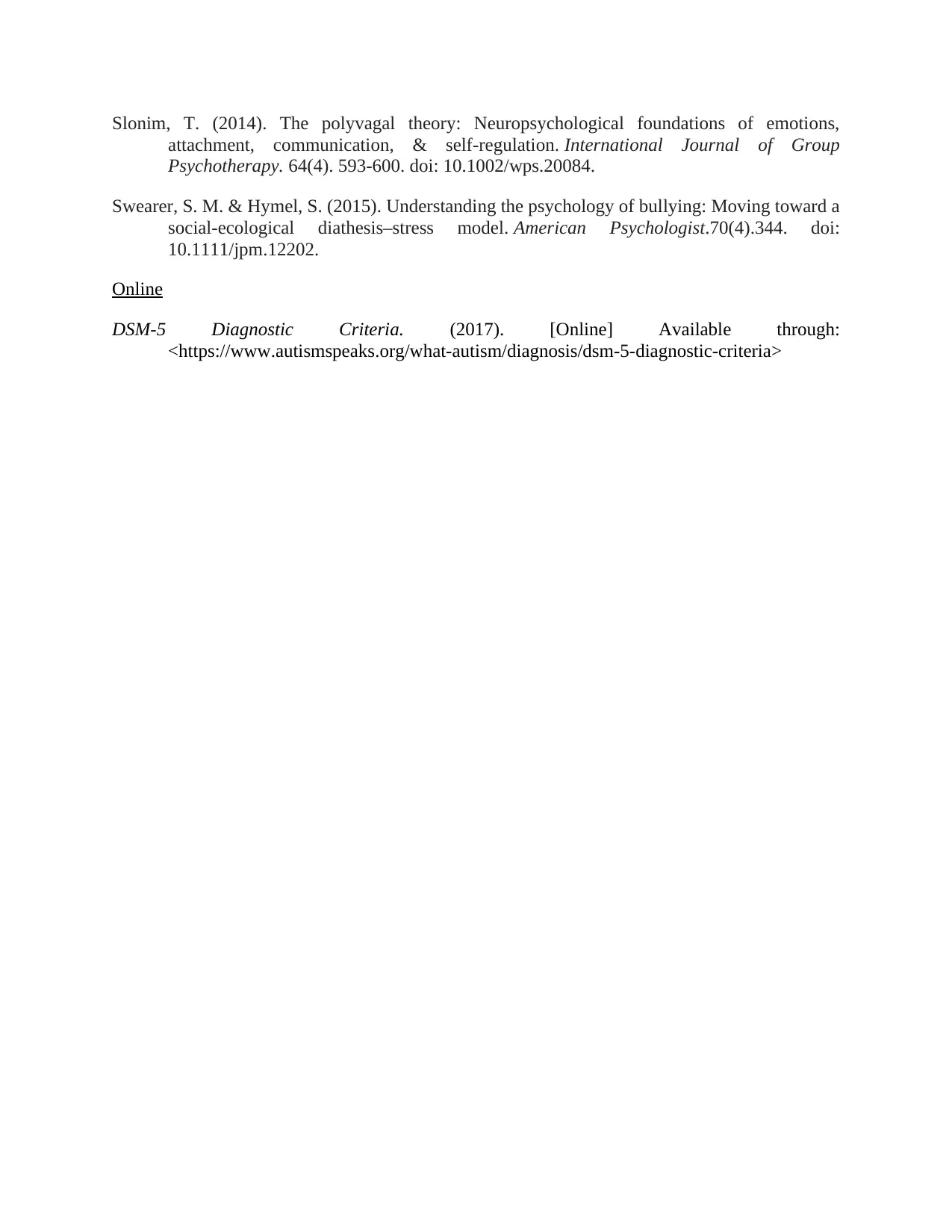
Slonim, T. (2014). The polyvagal theory: Neuropsychological foundations of emotions,
attachment, communication, & self-regulation. International Journal of Group
Psychotherapy. 64(4). 593-600. doi: 10.1002/wps.20084.
Swearer, S. M. & Hymel, S. (2015). Understanding the psychology of bullying: Moving toward a
social-ecological diathesis–stress model. American Psychologist.70(4).344. doi:
10.1111/jpm.12202.
Online
DSM-5 Diagnostic Criteria. (2017). [Online] Available through:
<https://www.autismspeaks.org/what-autism/diagnosis/dsm-5-diagnostic-criteria>
attachment, communication, & self-regulation. International Journal of Group
Psychotherapy. 64(4). 593-600. doi: 10.1002/wps.20084.
Swearer, S. M. & Hymel, S. (2015). Understanding the psychology of bullying: Moving toward a
social-ecological diathesis–stress model. American Psychologist.70(4).344. doi:
10.1111/jpm.12202.
Online
DSM-5 Diagnostic Criteria. (2017). [Online] Available through:
<https://www.autismspeaks.org/what-autism/diagnosis/dsm-5-diagnostic-criteria>
1 out of 8
Related Documents
Your All-in-One AI-Powered Toolkit for Academic Success.
+13062052269
info@desklib.com
Available 24*7 on WhatsApp / Email
![[object Object]](/_next/static/media/star-bottom.7253800d.svg)
Unlock your academic potential
© 2024 | Zucol Services PVT LTD | All rights reserved.





